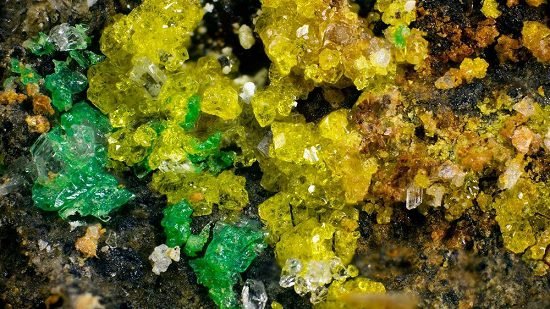Will be shown the mineral which has the most complex structure and the greater number of bits.
The mineral

The world’s most complex mineral is called Ewingite, was discovered in 2016. Found in Plavno uranium mine, in Western Bohemia, Czech Republic. This is the Ewingite’s chemical formula.
Mg_{8}Ca_{8}(UO_2)_{24}(CO_3)_{30}O_4(OH)_{12}(H_2O)_{138}
As can see in the formula, the Ewingite is based in uranium. This mineral is rare, probably for be formed in a narrow pH (indicator of acidity of a substance) band. Until now was found only in Plavno mine. It is believed that the Ewingite was formed after the exploitation of mine, interfering in the natural process, exposing the material to air.
Crystalline structure
This is a 2.3 nanometers cluster of Ewingite. Has 24 uranium polyhedra (yellow), the pink is the magnesium ion (Mg^{+2}), blue is calcium ion (Ca^{+2}) and black is the carbonate triangle.

Source: (Olds, 2016)
The structure has tetragonal symmetry.

The class is Ditetragonal Dipyramidal.

Bits per unit cell
This is the method to measure the crystal complexity. A unit cell is the smallest block which can be repeated to form a crystal.

Every cell unit is a parallelepiped, actually there are 7 types of unit.

The bits per atoms is based in Shannon’s equation, which calculates bits per symbol.
H=-\sum_{i=1}^{S}p_{i}\cdot \log_{2}pi
p_{i} is the probability to occur a symbol from group S in position i. This equation below calculates how many bits has an atom in a crystalline structure.
I_{G}=-\sum_{i=1}^{k}p_{i} \log_{2}pi
Where k is the number of crystallographic orbits, which are set points with symmetry in a structure, and p_{i} is the probability of have an atom in a crystallographic orbit i. Multiplying by number of atoms v in a cell unit, we have the number of bits in a cell unit.
I_{G,Total}=v\cdot I_{G}
Only 2.5% of minerals have more than 1000 bits per unit cell. The Ewingite has 12,684 bits per unit cell.



